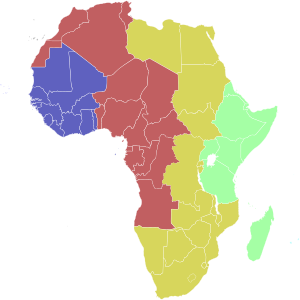
A time zone is an area which observes a uniform standard time for legal, commercial and social purposes. Time zones tend to follow the boundaries between countries and their subdivisions instead of strictly following longitude, because it is convenient for areas in frequent communication to keep the same time.

The Hawaii–Aleutian Time Zone observes Hawaii–Aleutian Standard Time (HST) by subtracting ten hours from Coordinated Universal Time (UTC−10:00). The clock time in this zone is based on the mean solar time of the 150th meridian west of the Greenwich Observatory.

Central European Time (CET) is a standard time of Central, and parts of Western Europe, which is one hour ahead of Coordinated Universal Time (UTC). The time offset from UTC can be written as UTC+01:00. It is used in most parts of Europe and in a few North African countries. CET is also known as Middle European Time and by colloquial names such as Amsterdam Time, Berlin Time, Brussels Time, Budapest Time, Madrid Time, Paris Time, Rome Time, Prague time, Warsaw Time or Romance Standard Time (RST).

UTC+08:00 is an identifier for a time offset from UTC of +08:00.

UTC+01:00 is an identifier for a time offset from UTC of +01:00. In ISO 8601, the associated time would be written as 2019-02-07T23:28:34+01:00. This time is used in:
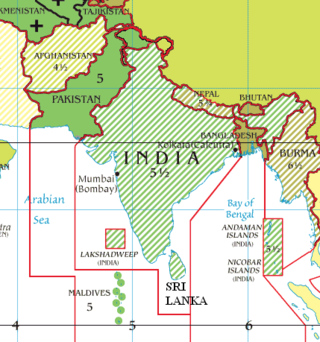
Bhutan Time (BTT) is the time zone of Bhutan. It is six hours ahead of UTC (UTC+06:00). Bhutan does not observe Daylight saving time.

Nepal Standard Time (NPT) is the time zone for Nepal. With a time offset from Coordinated Universal Time (UTC) of UTC+05:45 all over Nepal, it is one of only three time zones with a 45-minute offset from UTC.

The time in China follows a single standard time offset of UTC+08:00 based on the National Time Service Center of Chinese Academy of Sciences located in Mount Li, Lintong District, Xi'an City, Shaanxi Province, even though the country spans almost five geographical time zones. The official national standard time is called Beijing Time domestically because based on 120th meridian east that Beijing City is located, and China Standard Time (CST) internationally. Daylight saving time has not been observed since 1991. China Standard Time (UTC+8) is consistent across Mainland China, Hong Kong, Macau, Taiwan, as well as equivalent with Philippines, Singapore, Brunei, most of Mongolia, Malaysia, Irkutsk Time (Russia), Western Australia and Central Indonesia.
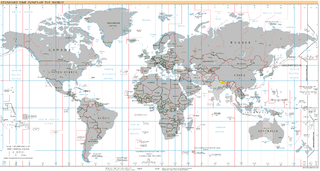
UTC+05:45 is an identifier for a time offset from UTC of +05:45. The time zone is used in Nepal. It is one of only three time zones with a 45-minute offset from UTC.
UTC+07:30 is an identifier for a time offset from UTC of +07:30.
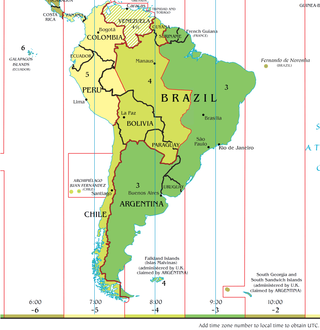
Argentina is located at a longitude that would naturally put it in the UTC−04:00 or UTC−05:00 time zone; however, it actually uses the UTC−03:00 time zone. Argentina determines whether to change clocks in observation of daylight saving time on a year-by-year basis, and individual provinces may opt out of the federal decision. At present, Argentina does not change clocks.
The UTC offset is the difference in hours and minutes between Coordinated Universal Time (UTC) and local solar time, at a particular place. This difference is expressed with respect to UTC and is generally shown in the format ±[hh]:[mm], ±[hh][mm], or ±[hh]. So if the time being described is two hours ahead of UTC, the UTC offset would be "+02:00", "+0200", or simply "+02".
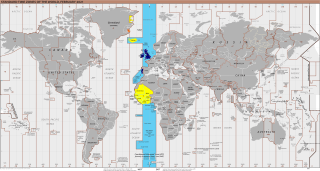
UTC+00:00 is an identifier for a time offset from UTC of +00:00. This time zone is the basis of Coordinated Universal Time (UTC) and all other time zones are based on it. In ISO 8601, an example of the associated time would be written as 2069-01-01T12:12:34+00:00. It is also known by the following geographical or historical names:

Central Africa Time or CAT, is a time zone used in central and southern Africa. Central Africa Time is two hours ahead of Coordinated Universal Time (UTC+02:00), which is the same as the adjacent South Africa Standard Time, Egypt Standard Time, Eastern European Time, Kaliningrad Time and Central European Summer Time.

West Africa Time, or WAT, is a time zone used in west-central Africa. West Africa Time is one hour ahead of Coordinated Universal Time (UTC+01:00), which aligns it with Central European Time (CET) during winter, and Western European Summer Time (WEST) / British Summer Time (BST) during summer.

East Africa Time, or EAT, is a time zone used in eastern Africa. The time zone is three hours ahead of UTC (UTC+03:00), which is the same as Moscow Time, Arabia Standard Time, Further-eastern European Time and Eastern European Summer Time.

Azerbaijan Time, abbreviated as AZT, is the standard time zone in Azerbaijan, four hours ahead of UTC (UTC+04:00). The daylight saving time adjustment, Azerbaijan Summer Time (AZST), was one hour ahead at UTC+05:00 and was introduced in 1997 and discontinued in March 2016.
East Timor uses UTC+09:00. In the west the country borders the UTC+08:00 zone of Central Indonesia and in the east the UTC+09:00 zone of that country. Daylight saving time is never observed in East Timor, due to its proximity to the equator; there is only a small variation between the length of day and night throughout the year. East Timor shares the same time zone with Japan Standard Time, Korean Standard Time, Pyongyang Time, Eastern Indonesia Standard Time, Palau Time, and Yakutsk Time (Russia).

In Turkey, time is given by UTC+03:00 year-round. This time is also called Turkey Time (TRT). The time at most is the same as in the Moscow Time and Arabia Standard Time zones. TRT was adopted by the Turkish Government on 8 September 2016. It was also in use in Northern Cyprus until it reverted to Eastern European Time (EET) in October 2017.
Africa, the world's second-largest and second-most populous continent, spans across six different time zone offsets from Coordinated Universal Time (UTC): UTC−01:00 to UTC+04:00. As Africa straddles the equator and tropics, there is little change in daylight hours throughout the year and as such daylight saving time is currently observed in only one country, Morocco, however it was also previously observed in several other countries.
